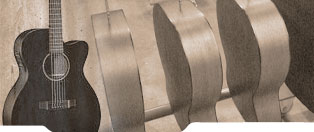
Roger McGuinn, founding member of the Byrds worked with C. F. Martin & Company to develop a seven-string folk guitar. McGuinn’s guitar (the D7) is tuned the same as a standard folk guitar with steel strings, but the third (G) string is augmented with a harmonic string one octave higher. The intention was to offer the six-string player the chance to play “jangly” twelve-string style lead guitar.
It takes anywhere from 6 weeks to three months to make a guitar. It can cost anywhere from $700 to $110,000 to buy a Martin guitar. Chris has two manufacturing plants. One facility is in Nazareth, Pennsylvania and the other in Mexico. He has been able to combine old world craftsmanship with modern technology at both places. He has been able employ people who are devoted to their craft. Naturally, in any business, a good CEO knows that technology is constantly changing and in order to survive, you need to embrace the change or your competitors will overtake you.
As a businessman, Chris became the CEO and Chairman through a rather circuitous route. At a young age, he lived for a while with his grandfather. He said that the two of them spent many hours speaking about the business and what it meant to his grandfather. Chris told me that when he eventually succeeded his father as head of the company, the conversations he had with his grandfather years earlier were invaluable to him.
What struck me was the fact that he has employees working in Nazareth that have been with the company for many years. Naturally, there are some jobs that require specific craftsman skills. However, for the times he purchases new equipment to increase productivity, he tells his co-workers that their current job is evolving. He says, “I would like you either learn a new job or I will teach you another job.” And since he first had that type of conversation with the workers twenty years ago, they have not laid off any employees. People of course move on or retire, but the bottom line is that the Martin family values their workers and by the way, employees of Martin guitars receive a share of the profits.
Eric Clapton plays a 000-42 style Martin Guitar
The tour of the plant took us through every step that included cutting the wood, matching a front and back of the guitar, constructing the sides, attaching the neck and fingerboard, polishing, adding the bridge and saddle, more polishing, attaching the strings, tuning the instrument and having applying yet another layer of quality control. There are people at the Martin factory whose job it is to play the finished guitar to make sure it sounds right.
Willie Nelson’s 1969 guitar, affectionately named “Trigger” is an N-20 Martin and he has no intentions of ever replacing it.
Running a company is an awesome responsibility. It takes skill and although one might say that you need a MBA degree from an accredited University School of Business to successfully run any large company. I say that’s true, but you also need common sense. Chris told the story of attending an industry Trade Show. A guy walks up to him and asks, “Can you tell me why everybody in this industry charges a premium price for a left-handed guitar? You guys are penalizing me. I was born this way!” So, Chris came back to the factory the next day and decided that it made no sense to charge more for a left-handed guitar and changed that policy. I suggested that he charge McCartney more for his left-handed guitars, but Chris rejected that idea.
In 1997, Martin launched its “Women in Music” series, which was followed in 1998 by the Joan Baez Signature guitar, a replica of the 0-45 Baez began her career with.
Martin guitars are guaranteed for life. Short of the guitar being run over by a car, they people at Martin will gladly accept of the damaged instrument and always repair their guitars. Martin is the largest manufacturer of high-end acoustic guitars in the world.
I was interested to know if any of the rock stars who use Martin guitars have ever visited the plant in Nazareth. Unfortunately, those visits out to the hills of Pennsylvania are few and far between. Usually what happens is that a representative from the Martin Artist Relations’ department travels to New York or wherever the artist is appearing to see and confer with them.
My favorite story involves the crown jewel of Martin Guitars, the D-45. Apparently, there were no D-45 models in the museum to display. At one point, Chris was offered an opportunity to purchase one, but the cost was well over $200,000 and the company was not in the financial position at that time to make that expenditure and he had to let it go. Years later, finances improved and Chris was once again given the opportunity to buy a D-45. This time the cost was approximately $250,000. He went to his Board of Directors and conferred with them on the purchase that D-45., even though as Chairman he could have made the purchase anyway and now that D-45 sits proudly in the Martin Museum.
Now that the company is doing well, Chris would like to make the transition from CEO & Chairman to just being Chairman. He’s been the CEO since 1987 and feels it’s time to devote his energies in other areas. He has done a remarkable job of blending old world wood working skills with modern robotic machines that produce exceptional instruments.
If I could choose what to come back as, it would be a Martin OM-45……Eric Clapton


No Comments comments associated with this post